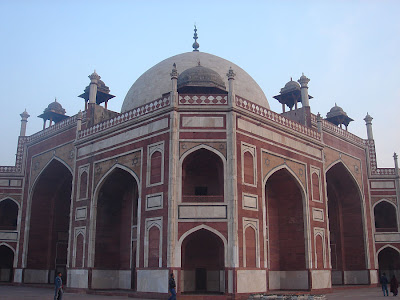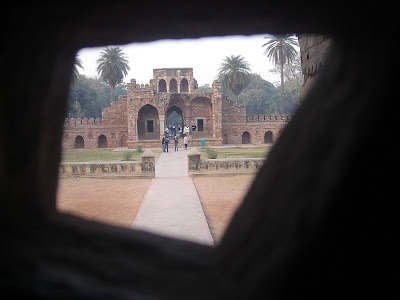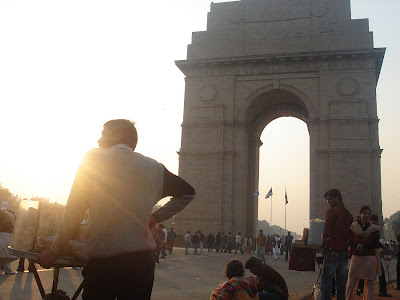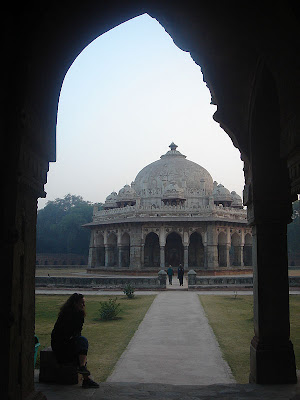I go to the FRRO
Chanakyapuri & Nizamuddin, Delhi
After spending the better part of a day running from one office (used to be the Foreigners' Regional Registration office, but that shifted some three years ago...not reflected on maps of course) to another (yes, this is the FRRO but you need to go to yet another Foreigners' office, in another part of town) to yet a third (yes, this is the right office but despite the fact that we're all present and it's only 3pm, you will have to come back Monday between 10 and 12 only) - after such a day, what I wanted was a little escapism.
part of a day running from one office (used to be the Foreigners' Regional Registration office, but that shifted some three years ago...not reflected on maps of course) to another (yes, this is the FRRO but you need to go to yet another Foreigners' office, in another part of town) to yet a third (yes, this is the right office but despite the fact that we're all present and it's only 3pm, you will have to come back Monday between 10 and 12 only) - after such a day, what I wanted was a little escapism.
(Just in case you have to pay them a visit, the FRRO is currently out near the Hyatt Hotel in an area called Bhikaji Cama Place, Ramakrishna Puram. None of the guidebooks show this yet. They all show it as still in Hans Bhavan near Pragati Maidan. )
(Long ago, back in the heady days of the early 80s, I owned an ancient James Brown 45rpm record called "Escapism (Parts 1 & 2)." For those of you who have never seen a 45rpm, Part 1 was on side 1 and part 2 was on what we used to call the B-side. James pronounced it eee-SKAY-pizm. It's probably worth a lot of money now, wherever it is. Other than a chance to mention James Brown, there is no point to this anecdote, so I will stop now.)
what we used to call the B-side. James pronounced it eee-SKAY-pizm. It's probably worth a lot of money now, wherever it is. Other than a chance to mention James Brown, there is no point to this anecdote, so I will stop now.)
As I have mentioned before, Delhi has a lot in common with Washington, DC. Both cities are national capitols, obviously, but it goes beyond that. They share very well-planned streets, meticulous greenways, many museums, lots of white marble, and lots and LOTS of memorials.
Luckily, the third office (called Jaisalmer House, for the curious) was walking distance from the giant Arc-de-Triomphe-like India Gate, which I had never seen properly, so I took a stroll. India Gate and surrounding well-groomed grounds were full of tourists, hawkers (selling everything from cotton candy to plastic beads to slices of star-fruit to my favourite orange popsicles), armed guards and police, and the crew of men erecting scaffolding and awnings for upcoming Republic Day (January 26).
Republic Day is an annual mega-spectacle of patriotism, pageantry and military might. I have never seen it on location - frankly you probably get a better view with less hassle on the national TV coverage. I love the way each state chooses a theme for their parade float. Bihar, surprisingly enough, usually chooses "the Buddha" rather than kidnapping or corruption, and Gujarat has chosen to stay away - so far- from the popular "communal violence" theme. I think this year the float will just be a giant mockup of Narendra Modi's big fat face with dozens of people wearing the Modi Mask riding aboard.
I have never seen it on location - frankly you probably get a better view with less hassle on the national TV coverage. I love the way each state chooses a theme for their parade float. Bihar, surprisingly enough, usually chooses "the Buddha" rather than kidnapping or corruption, and Gujarat has chosen to stay away - so far- from the popular "communal violence" theme. I think this year the float will just be a giant mockup of Narendra Modi's big fat face with dozens of people wearing the Modi Mask riding aboard.
The India Gate is essentially a war memorial, engraved all over with names of Indian who gave their lives in various wars. I wondered if there were always so many armed guards - you can't even walk under the arch or touch the pillars (which are at a considerable distance from the arch itself). Are all national symbols being guarded so fiercely in today's terrorist environment? Or, was it just in the run-up to Republic Day?
For those of you who haven't been to India yet (like my 2 sisters -though they say they are coming this year), watching the tent-masters erect these pavilions and awnings is a uniquely Indian experience. Very few buildings are large enough to house Indian crowds, so we just make a temporary "building" outdoors.
If you have seen the movie Monsoon Wedding, you have some idea of the process. Out of nowhere, a green field or dusty lot will be transformed with cloth walls and roofing (and sometimes even jute carpet flooring) for 1000s of people. Using bamboo poles, hand-made bamboo ladders, kilometres of jute rope and acres of cloth sheeting, the tent-wallahs were constructing awnings, railings and so on to protect 10s of thousands on Republic Day. A street dog had found a comfy bed, crashed out atop a coil of rope four feet high.
On the peacock lawn
Dusk was approaching and I realized I was a Delhi stone's throw from Humayan's Tomb, a World Heritage site that has been on my to-see list forever. So I splurged on yet another autorickshaw (40Rs from India Gate) to Nizamuddin. Admission is supposed to be $5 for foreigners, but as they have set the rate at 250Rs it is now $6.00.
that has been on my to-see list forever. So I splurged on yet another autorickshaw (40Rs from India Gate) to Nizamuddin. Admission is supposed to be $5 for foreigners, but as they have set the rate at 250Rs it is now $6.00.
It's worth it. Humayan's Tomb was the first of its kind (Mughal four-quartered gardens with tombs) and evidently the prototype for the Taj Mahal. It's not just one tomb, it is an enormous enclave of geometric gardens, waterways, fountains and several giant tombs, built in the 1570s - any one of which would be worth seeing on its own. The purple haze of twilight gives the buildings a romantic, lost-civilization feel.
Since it was nearing closing time, I hurried through the first two mausoleums, which already felt like something from an orientalist Arabian Nights scenario - octagonal buildings of marble, onion domes, marble latticework windows surrounded by date palm trees. In fact I would recommend going in the morning - the complex opens at dawn - in hopes of seeing sunlight filter through the intricate patterns of lacey marble.
Then I caught a glimpse of the main attraction through the mammoth arched gateway. I couldn't help breathing "Ohhhh!"
The actual tomb of Humayan is a dream, glowing in red sandstone. It is elegant and ornate without ever being garish or baroque. Every one of its many marble-jali windows seemed to have a different geometric pattern, echoed in the marble inlays on the floor.
A gaggle of western art students emerged from the front archway, clutching their sketch books, now filled with the geometric designs. As the sun sank, a call to prayer went up from the neighboring DhamDhama Sikh Gurudwara, with its own dome visible just over the ancient fence. Okay, wrong religion historically, but to hear such devotional music in that setting at sunset really makes my spirit soar. Bright green parrots shrieked as they streaked around the sky.
On Global Voices
Yesterday's post about dynastic democracies made it to Global Voices. If I had known people were actually reading it, I would have put more work into it....
Chanakyapuri & Nizamuddin, Delhi
After spending the better
 part of a day running from one office (used to be the Foreigners' Regional Registration office, but that shifted some three years ago...not reflected on maps of course) to another (yes, this is the FRRO but you need to go to yet another Foreigners' office, in another part of town) to yet a third (yes, this is the right office but despite the fact that we're all present and it's only 3pm, you will have to come back Monday between 10 and 12 only) - after such a day, what I wanted was a little escapism.
part of a day running from one office (used to be the Foreigners' Regional Registration office, but that shifted some three years ago...not reflected on maps of course) to another (yes, this is the FRRO but you need to go to yet another Foreigners' office, in another part of town) to yet a third (yes, this is the right office but despite the fact that we're all present and it's only 3pm, you will have to come back Monday between 10 and 12 only) - after such a day, what I wanted was a little escapism.(Just in case you have to pay them a visit, the FRRO is currently out near the Hyatt Hotel in an area called Bhikaji Cama Place, Ramakrishna Puram. None of the guidebooks show this yet. They all show it as still in Hans Bhavan near Pragati Maidan. )
(Long ago, back in the heady days of the early 80s, I owned an ancient James Brown 45rpm record called "Escapism (Parts 1 & 2)." For those of you who have never seen a 45rpm, Part 1 was on side 1 and part 2 was on
 what we used to call the B-side. James pronounced it eee-SKAY-pizm. It's probably worth a lot of money now, wherever it is. Other than a chance to mention James Brown, there is no point to this anecdote, so I will stop now.)
what we used to call the B-side. James pronounced it eee-SKAY-pizm. It's probably worth a lot of money now, wherever it is. Other than a chance to mention James Brown, there is no point to this anecdote, so I will stop now.)As I have mentioned before, Delhi has a lot in common with Washington, DC. Both cities are national capitols, obviously, but it goes beyond that. They share very well-planned streets, meticulous greenways, many museums, lots of white marble, and lots and LOTS of memorials.
Luckily, the third office (called Jaisalmer House, for the curious) was walking distance from the giant Arc-de-Triomphe-like India Gate, which I had never seen properly, so I took a stroll. India Gate and surrounding well-groomed grounds were full of tourists, hawkers (selling everything from cotton candy to plastic beads to slices of star-fruit to my favourite orange popsicles), armed guards and police, and the crew of men erecting scaffolding and awnings for upcoming Republic Day (January 26).
Republic Day is an annual mega-spectacle of patriotism, pageantry and military might.
 I have never seen it on location - frankly you probably get a better view with less hassle on the national TV coverage. I love the way each state chooses a theme for their parade float. Bihar, surprisingly enough, usually chooses "the Buddha" rather than kidnapping or corruption, and Gujarat has chosen to stay away - so far- from the popular "communal violence" theme. I think this year the float will just be a giant mockup of Narendra Modi's big fat face with dozens of people wearing the Modi Mask riding aboard.
I have never seen it on location - frankly you probably get a better view with less hassle on the national TV coverage. I love the way each state chooses a theme for their parade float. Bihar, surprisingly enough, usually chooses "the Buddha" rather than kidnapping or corruption, and Gujarat has chosen to stay away - so far- from the popular "communal violence" theme. I think this year the float will just be a giant mockup of Narendra Modi's big fat face with dozens of people wearing the Modi Mask riding aboard. The India Gate is essentially a war memorial, engraved all over with names of Indian who gave their lives in various wars. I wondered if there were always so many armed guards - you can't even walk under the arch or touch the pillars (which are at a considerable distance from the arch itself). Are all national symbols being guarded so fiercely in today's terrorist environment? Or, was it just in the run-up to Republic Day?
For those of you who haven't been to India yet (like my 2 sisters -though they say they are coming this year), watching the tent-masters erect these pavilions and awnings is a uniquely Indian experience. Very few buildings are large enough to house Indian crowds, so we just make a temporary "building" outdoors.
If you have seen the movie Monsoon Wedding, you have some idea of the process. Out of nowhere, a green field or dusty lot will be transformed with cloth walls and roofing (and sometimes even jute carpet flooring) for 1000s of people. Using bamboo poles, hand-made bamboo ladders, kilometres of jute rope and acres of cloth sheeting, the tent-wallahs were constructing awnings, railings and so on to protect 10s of thousands on Republic Day. A street dog had found a comfy bed, crashed out atop a coil of rope four feet high.
On the peacock lawn
Dusk was approaching and I realized I was a Delhi stone's throw from Humayan's Tomb, a World Heritage site
 that has been on my to-see list forever. So I splurged on yet another autorickshaw (40Rs from India Gate) to Nizamuddin. Admission is supposed to be $5 for foreigners, but as they have set the rate at 250Rs it is now $6.00.
that has been on my to-see list forever. So I splurged on yet another autorickshaw (40Rs from India Gate) to Nizamuddin. Admission is supposed to be $5 for foreigners, but as they have set the rate at 250Rs it is now $6.00.It's worth it. Humayan's Tomb was the first of its kind (Mughal four-quartered gardens with tombs) and evidently the prototype for the Taj Mahal. It's not just one tomb, it is an enormous enclave of geometric gardens, waterways, fountains and several giant tombs, built in the 1570s - any one of which would be worth seeing on its own. The purple haze of twilight gives the buildings a romantic, lost-civilization feel.
Since it was nearing closing time, I hurried through the first two mausoleums, which already felt like something from an orientalist Arabian Nights scenario - octagonal buildings of marble, onion domes, marble latticework windows surrounded by date palm trees. In fact I would recommend going in the morning - the complex opens at dawn - in hopes of seeing sunlight filter through the intricate patterns of lacey marble.
Then I caught a glimpse of the main attraction through the mammoth arched gateway. I couldn't help breathing "Ohhhh!"
The actual tomb of Humayan is a dream, glowing in red sandstone. It is elegant and ornate without ever being garish or baroque. Every one of its many marble-jali windows seemed to have a different geometric pattern, echoed in the marble inlays on the floor.
A gaggle of western art students emerged from the front archway, clutching their sketch books, now filled with the geometric designs. As the sun sank, a call to prayer went up from the neighboring DhamDhama Sikh Gurudwara, with its own dome visible just over the ancient fence. Okay, wrong religion historically, but to hear such devotional music in that setting at sunset really makes my spirit soar. Bright green parrots shrieked as they streaked around the sky.
On Global Voices
Yesterday's post about dynastic democracies made it to Global Voices. If I had known people were actually reading it, I would have put more work into it....














4 comments:
Baraka;
Baraka is one of my most savoured movies!
It takes a sobering look at the world around us and leaves us with questions;
How did you come across it?
Please reply to the Baraka blog and check out my mad world mundo loco blog, if you have the time.
the Celtic man**
How did I come across it? the question is how did you come across the fact that I came across it?? ;-) via my Facebook profile?
I've known of it for about a decade but finally saw it at a film fest in Auroville, Tamil Nadu India. It's a real religious experience in the true sense...a meditation on man's relationship to the infinite. Thanks for writing!~
your profile has it as your number one movie!
thanks for the response and I will comment again.
the Keltic man**
Thanks Robert, cead mille failte!
Baraka is truly phenomenal and a meditation on film.....
Post a Comment